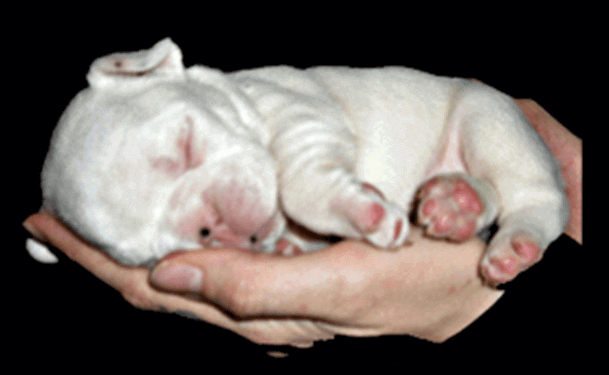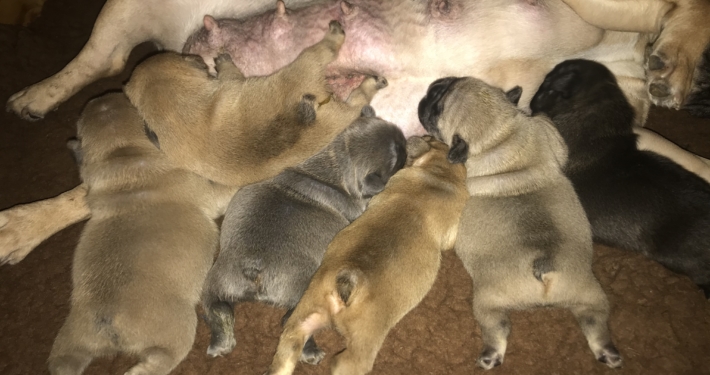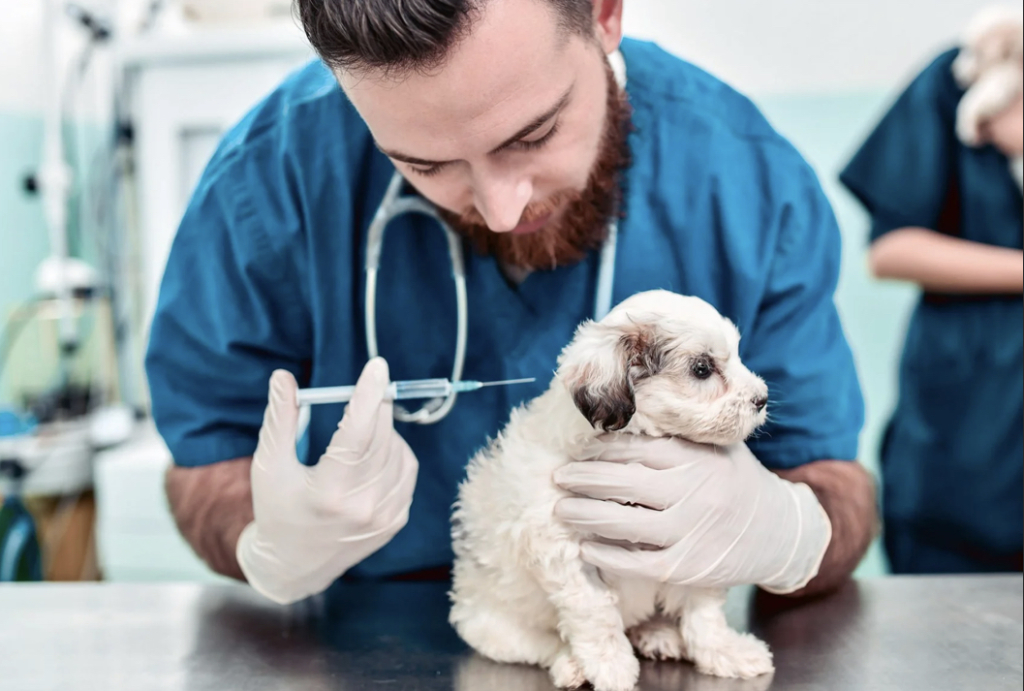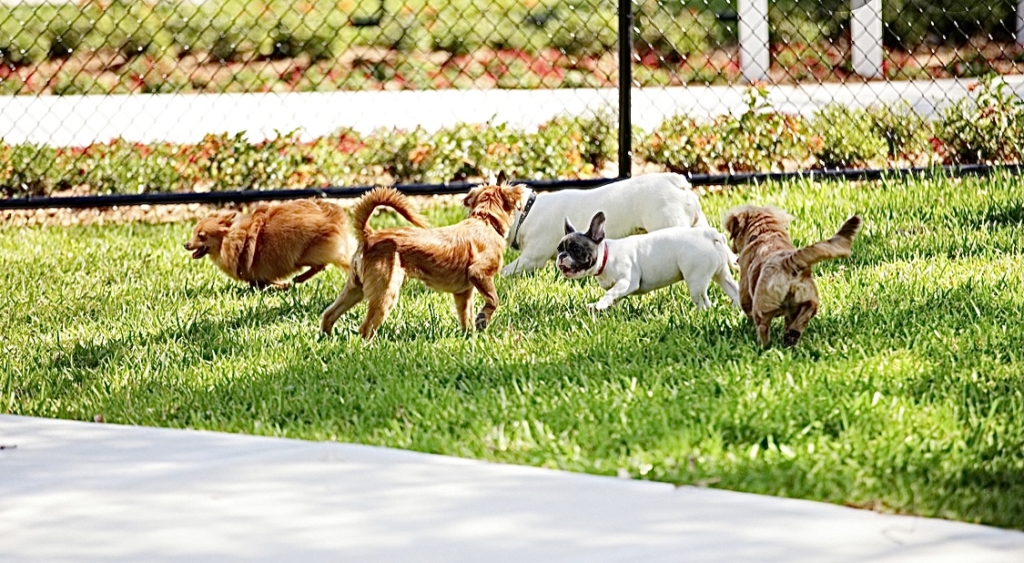RANGE currently is $4000 and up.
French Bulldogs, known for their unique charm and adorable looks, have a breeding process that significantly influences their cost and price. For starters, French Bulldogs are typically conceived through artificial insemination due to their physical structure, which makes natural mating challenging. This procedure involves careful timing, often determined by progesterone testing. Each test costs approximately $75, and it’s conducted about four times before the breeding process begins. These steps ensure optimal conditions for successful fertilization, contributing to the overall price of French Bulldog puppies.
Once pregnancy is confirmed—usually through an ultrasound or X-ray, each costing about $150—the countdown to delivery begins. French Bulldogs reach full term at around 60 days. However, due to their anatomy, these dogs cannot safely deliver puppies naturally. While there are rare cases of natural births, complications often arise, potentially endangering both the mother and the puppies. For this reason, breeders typically opt for cesarean sections, which cost between $1,500 and $3,000 depending on the litter size.
After delivery, the puppies require immediate care to ensure they thrive. They are often placed in an incubator at the veterinary clinic until their body temperatures stabilize. Once stable, they are brought to their mother, who, despite undergoing major surgery, is usually alert and ready to care for her litter. The first moments after birth are critical as the puppies must latch and suckle to receive colostrum, essential for building their immune systems.
The meticulous care and medical interventions required for French Bulldog breeding and delivery significantly impact their overall cost and price. This process not only ensures the safety of the mother and puppies but also reflects the investment made by breeders to provide healthy, well-cared-for dogs. Understanding these factors helps clarify why French Bulldogs command such a premium price.
“Baby puppies will naturally eat every hour and 15 minutes to hour and a half so we push the envelope just a bit and push it to two hours so we can at least sleep those two hours.”
NOW, Imagine the next 28 days you’re not allowed to sleep through the night you have to set an alarm clock for two hours after you fall asleep and you’re up for an hour and then you can sleep for two more and then you’re up for an hour and you can sleep for two more. This is what the night is like when you have a litter of French bulldog puppies. The mother dog’s tits are so big and she is so unknowing of all the little wiggling bodies around her that there is an extremely high risk of her accidentally squishing a puppy so you cannot leave her unattended with her babies. Baby puppies will naturally eat every hour and 15 minutes to hour and a half so we push the envelope just a bit and push it to two hours so we can at least sleep those two hours. Then the puppies are placed on her nipples she is taught in the early days what it is to lick their behinds because if she doesn’t then they won’t defecate and if they don’t poop they will become sick and could die. Often in the beginning and especially with a new mother you use a warm cotton ball to simulate her tongue licking them and this will make them poop. So they need to drink, they need to poop, we need to make sure that everybody’s sucking correctly and only after that roughly half an hour later you take the puppies off the mother dog even though they will have fallen asleep and you have to separate them if you want to sleep because you cannot leave her alone with those puppies. Unless those puppies are secured in a separate crate or the mother dog is locked out of the room which is torture for her. There must be a system in place where she cannot physically get to those puppies by for example pushing and throwing and turning a crate throughout the room with infant puppies flying around inside. I’m describing something that I’ve actually seen happen. Incredibly, that day no one died but it was a close call after that I used bungee cords and heavy weights on top of the crate to make sure we didn’t repeat that behavior.
CLICK on IMAGE TO START SLIDESHOW
“A special whelping box is designed so that when the mother does lay in the nest with the puppies and she leans back potentially rolling onto a puppy that the puppy can be protected…”
And so it goes for the next three weeks! At about 10 days the eyes are opened and puppies have doubled in size and are more able to start moving around creating yet an even higher risk. A special whelping box is designed so that when the mother does lay in the nest with the puppies and she leans back potentially rolling onto a puppy that the puppy can be protected underneath a sort of a shelf that wraps around the perimeter of the inside of the nest
“…get a puppy at this age you can have a sense of the quality of the dog that you’re buying.”
Between three and four weeks babies start to stand up and walk around, an early bloomer can be running at four weeks but the average dog it takes till five. This fast progress and development is evidence of a pattern that will persist till 16 weeks of age. This swift development demonstrates the inability to truly evaluate a puppy at eight weeks as change is so significant for what continues for another eight weeks. This is one of the many reasons that supports us holding our puppies back until 16 weeks of age before we let them go. If you get a puppy at this age you can have a sense of the quality of the dog that you’re buying. By now chests and four legs are starting to chunk up and an absolute difference can be seen between the heads of different pups knowing if you’ve got one with a bigger head or a smaller head. Also the whole notion of a small French bulldog or a big French bulldog cannot be evaluated either until about the age of 16 weeks. If it’s 16 weeks and you have a pup that is running small you can now be more certain that the smallness that you see is an indicator of a smaller full grown French bulldog. Make a note here that there is NO SUCH THING as a MINI French bulldog. This breed has not been made into a miniature. The only exception might be someone that is crossing them with Chihuahuas and the breeders that are doing that probably won’t admit it to you. The sad thing about that is is that it is the nature of the French bulldog that is so magnetic will be compromised if you cross it with a Chihuahua or anything else and then you cannot be certain of the nature of the dog you would be getting. So beware of people anyone who says they’re selling you a mini is lying! There are however, smaller-bodied dogs often referred to as “compact” or “short” french bulldog.
“A Boston Terrier and a French Bulldog at 8 weeks cannot be told apart.”
Little known fact that if you took an eight week old Boston terrier and stuck it in a nest with French bulldog puppies the average person would not be able to spot the difference. It’s for this reason the people should be concerned about what they’re choosing from breeders that let their puppies go at eight weeks because you really can’t tell what you’re getting.
“By 5 weeks a puppy is eating on their own. Nursing is done by 7 weeks.”
Let’s go back for a minute to the basics: around five weeks of age puppies are really ready to start weaning. You can begin the process as early as three weeks with just minor licking and mess making or wait a little bit longer and see faster and less messy progress as puppies can bite down and swallow food at this tender age. We begin with a pablum something like baby cereal mixed with goats milk and quickly progress to porridge specially designed for infant puppies, a kibble soaked in water. This soaked kibble is their first introduction to water away from mothers milk. The goats milk is a substitute but we also want to wean them off of by seven weeks of age. If no attention is paid a mother dogs milk will pretty much dry up by seven weeks of age but Puppies will continue to try and pursue the mothers tits when at all possible as long as they are allowed. It’s interesting here to mention that a mother dog must eat three times her normal diet to sustain a healthy body weight while nursing all these puppies.
“We are not supporting over vaccinating. In an effort to do less which is better we encourage TITER TESTING”.
This brings us now to the topic of vaccines. Many breeders live in fear that their puppies will be exposed to a nasty germ and they are hasty to give vaccines to these young puppies as early as 4 to 6 weeks. Parvo and distemper are the primary diseases that we all fear. Here is the problem though with giving those early vaccines. The puppies carry antibodies from nursing on the mother. These antibodies will dissipate but we don’t really know when it is: week after they stop nursing or a month after they stop nursing. Nonetheless, as long as those antibodies are present in their body any vaccine will be attacked by the antibodies as if it were disease rendering, that vaccine becomes null and void. These antibodies are referenced as maternal antibodies in the literature and they are the reason that early vaccines are typically ineffective. It’s for this reason that vaccines are now given again and again on average every 2 to 3 weeks starting at six weeks of age with many breeders repeating at 8 weeks and 10 weeks and 12 weeks and 16 weeks of age.
If you are a parent and have young children I pose the question: would you re-vaccinate your children over and over and over again on the off chance that the first vaccine didn’t work? This is a timely topic in the advent of Covid vaccines. Have you received a Covid vaccine and if so how would you feel if I told you you had to repeat it over and over again every few months?
In an effort to optimize good health we are trying to not give as many vaccines so early in life. Actual scientific studies support that less is better. When puppies were tested for antibodies after given vaccines at nine and 12 weeks versus one single vaccine at 13 weeks the puppies that had one vaccine, more of them showed high antibody counts at 20 weeks of age when the blood was tested than the dogs that had multiple vaccines. This again would indicate that the vaccines are competitive with one another rendering certain components again null and void
We advocate titer testing (for antibodies) where blood is drawn at least at 15 weeks before yet another vaccine is given typically at 16 weeks. The majority of dogs will pass the titer test and never need another vaccine if the last one they received was at 13 weeks. By doing this titer test you can also prevent giving an unnecessary vaccine with five different diseases in it. Worst case scenario the puppies titer might have shown weakness in antibodies for distemper. In that event we give a vaccine that contains only that one ingredient for distemper. That particular vaccine activates within 48 hours so two days later you can be literally on the road with your dog on a leash walking for the first time and/or in a public dog park feeling safe.
“Dogs are dogs and not human. They are pack animals and thrive in the presence of other dogs.”
Housebreaking: Beginning back to three weeks of age we already start to put pee pads in the nest. Our puppies are learning at a very young age that they want to go potty on those pee pads. This is why we have such good results and puppies going out the door that aren’t pissing around your house the way many young puppies would not knowing any better. We make sure they know better by introducing the pee pads at an extremely young age.
Sometimes I find myself defending the fact that I’m holding my dogs back until they’re 16 weeks and fully vaccinated because people seem to think that this is not anymore a puppy. Hogwash! do your homework! a dog is not full grown until nearly a year. Four months is only 1/3 of the way there and this does not include the additional growth of the head and the chest that happens well up until two years of age. If you ask any VET they will tell you their number one customer is puppies under the age of 16 weeks! Our intention is to be responsible and not put upon you, the buyer, a weak young baby puppy that is not yet safe. What many people overlook is the importance of socializing the young pup when it leaves its family that it’s used to and all the other dogs. The idea that you would take home an eight week old puppy and then isolate it with your family but no other dogs is heartbreaking for me to hear and consider. These are the dogs that grow up with emotional anxiety disorders, separation anxiety, barking and just plain old nervous stuff. Dogs are pack animals they should not be left alone. My goodness, at least get a kitten if nothing else! It can be a successful union, a cat and a dog. We are talking about dogs here not humans don’t forget. Dogs need other dogs.
“Socializing your new puppy is of optimum importance. We don’t let dogs go till fully vaccinate so there is no excuse for isolating a young puppy. It is detrimental to their mental health.”
Unless you have another dog you need to consider how you will socialize your puppy so now if you take home a 16 week old puppy that is fully vaccinated you can IMMEDIATELY utilize the benefits of the dog park and all your friends and family and neighbors with dogs to help encourage a completely healthy dog emotionally.
Our intention and passion is to do only what is in the best interest of the dog and that would be keeping it with his family through all of its vaccinations and a full weaning to a healthy raw diet before it begins a new life in the world away from everything that they know
“We have been in business for over 20 years. Dr. Zoll is a clinical psychologist and expert in this breed, the french bulldog.”
RANGE currently is $4000 and up.
Standard colors $4000-$5500
Blue Fawns $5000-$6500
Blues $6000-$7500
Merles $7500-$9500
Isabella Carriers $7500-$8500
THE MATH
The HOURS invested in bringing up one dog for four months is equal To approximately 1000 hours, (122 days x 8 hours/day = 976 hours) this is a very conservative estimate. We are busy for more than eight hours per day with our dogs involvement of cleaning and feeding three times per day and socializing and playing. If we were to consider a minimum wage of $15 per hour the investment just in time would be equal to $15,000 in FOUR months if we had to pay somebody to do this job for us.
So now when you ask the question why are French bulldogs so expensive I hope you will have a broader perspective and perhaps feel more respect for the investment in the readers time to get the dog to the point of FOUR months when you will take it home.
We have been in business for over 20 years and our dogs come with the following…
- AKC or CKC Papers
- Fully Vaccinated
- Socialized
- Dewormed
- 1 year Health Guarantee
- 6 month Health Guarantee Extension (if administer daily NuVet Supplements)
- Raw Diet Ready
- Starter Supply Kit: 4lbs raw food, bully stick, hoof and supplements
- Health Consult for the life of your dog
We have satisfied many families over the years. You can find us on Yelp and see our reviews. We hope to see you soon at one of our locations in Ojai, Ventura or Los Angeles. Come see our puppies and kennels, bring your family!

































































